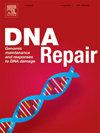"Yin-Yang" of PARP1 in genotoxic and inflammatory response
IF 2.7
3区 生物学
Q2 GENETICS & HEREDITY
引用次数: 0
Abstract
Poly(ADP-ribose) polymerase 1 (PARP1), the founding member of the PARP superfamily, is an enzyme with poly-ADP-ribosyltransferase activity that conducts the majority of poly-ADP-ribosylation (PARylation). PARP1 is the most extensively studied member of the PARP family. It plays a role in various biological processes, particularly in DNA damage repair, including base excision repair, single-strand break repair, double-strand break repair, and maintenance of replication fork stability. Besides DNA damage repair, PARP1 is also involved in the inflammatory response, including, but not limited to, the NF-κB, JAK-STAT, inflammasome assembly, and cGAS-STING signaling pathways. As a scaffold and enzyme, PARP1 and its mediated PARylation induce genotoxic and inflammatory responses to various intracellular and extracellular stressors. Thus, PARP1 has been a target as a pharmaceutical intervention for a range of pathological conditions, including cancer and inflammatory diseases. This review article attempts to provide a comprehensive view of PARP1 as a bridging point between genotoxic and inflammatory responses.
PARP1基因毒性和炎症反应的“阴阳”关系
聚(adp -核糖)聚合酶1 (PARP1)是PARP超家族的创始成员,是一种具有聚adp -核糖基转移酶活性的酶,可进行大多数聚adp -核糖基化(PARylation)。PARP1是PARP家族中研究最广泛的成员。它在多种生物过程中发挥作用,特别是在DNA损伤修复中,包括碱基切除修复、单链断裂修复、双链断裂修复和维持复制叉稳定性。除了DNA损伤修复外,PARP1还参与炎症反应,包括但不限于NF-κB、JAK-STAT、炎性体组装和cGAS-STING信号通路。作为一种支架和酶,PARP1及其介导的PARylation可诱导对各种细胞内和细胞外应激源的遗传毒性和炎症反应。因此,PARP1已成为一系列病理状况(包括癌症和炎症性疾病)的药物干预靶标。这篇综述文章试图提供PARP1作为基因毒性和炎症反应之间的桥梁点的全面观点。
本文章由计算机程序翻译,如有差异,请以英文原文为准。
求助全文
约1分钟内获得全文
求助全文
来源期刊

DNA Repair
生物-毒理学
CiteScore
7.60
自引率
5.30%
发文量
91
审稿时长
59 days
期刊介绍:
DNA Repair provides a forum for the comprehensive coverage of DNA repair and cellular responses to DNA damage. The journal publishes original observations on genetic, cellular, biochemical, structural and molecular aspects of DNA repair, mutagenesis, cell cycle regulation, apoptosis and other biological responses in cells exposed to genomic insult, as well as their relationship to human disease.
DNA Repair publishes full-length research articles, brief reports on research, and reviews. The journal welcomes articles describing databases, methods and new technologies supporting research on DNA repair and responses to DNA damage. Letters to the Editor, hot topics and classics in DNA repair, historical reflections, book reviews and meeting reports also will be considered for publication.
 求助内容:
求助内容: 应助结果提醒方式:
应助结果提醒方式:


